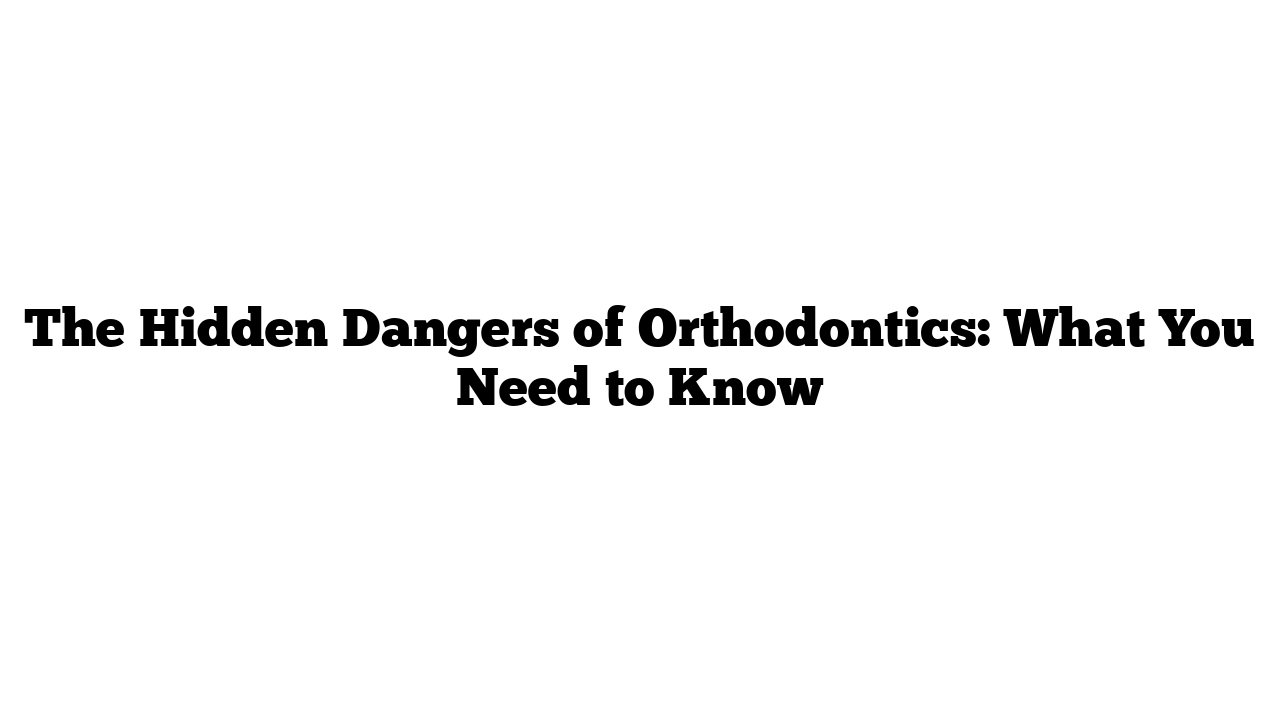Orthodontics is widely celebrated for its ability to straighten teeth and create beautiful smiles. However, there are hidden risks many don’t realize until years later. While traditional orthodontic treatments focus on aesthetics, they sometimes neglect critical factors like breathing, tongue space, and long-term oral health. Let’s explore these risks, what causes them, and how health-based orthodontic practices can make a difference.
The Hidden Risks of Orthodontics
1. Reduced Oral Space
In traditional orthodontics, making room for straight teeth sometimes involves extracting teeth or reducing tooth size with a technique called interproximal reduction (IPR). While this can quickly create space, it may inadvertently reduce the room needed for the tongue and other oral tissues to function properly.
This reduced space can cause:
- Sleep disorders: Restricted airways can lead to conditions like sleep apnea or snoring.
- Chronic fatigue: Poor sleep quality often results in daytime drowsiness and difficulty concentrating.
- Health complications: Insufficient oxygen during sleep can contribute to high blood pressure, heart issues, and autoimmune disorders.
2. The Retainer Dilemma
Orthodontic treatment often requires a retainer to keep teeth in their new position. However, if teeth need constant retention, it’s a sign they weren’t placed in a naturally stable position. Teeth naturally balance between the forces of the lips, cheeks, and tongue. When this balance is disrupted, they shift, leading to the need for repeated treatments.
3. Tooth Decay and Long-Term Damage
Orthodontic hardware like braces can make teeth harder to clean, increasing the risk of cavities. Fillings placed during adolescence often require multiple replacements over a lifetime, eventually leading to:
- Crowns or veneers
- Root canals
- Tooth loss
The Health-Based Orthodontics Approach
At Total Care Dental, we take a different approach—prioritizing oral health, breathing, and tissue function over purely cosmetic results. Here’s how:
1. Expanding the Mouth, Not Extracting Teeth
Instead of removing teeth to create space, we focus on expansion. Expanding the jaw provides adequate room for all teeth, the tongue, and soft tissues. This method:
- Improves airway health, reducing the risk of sleep apnea.
- Promotes better alignment naturally, minimizing future movement.
2. Treating the Whole System
We evaluate not just teeth but also the tongue, lips, cheeks, and airway. If the tongue is tied or tissues are too restricted, we address these issues alongside orthodontic treatment.
3. Preventing Tooth Decay
Our removable expanders and clear aligners allow for better oral hygiene compared to traditional braces. This reduces the risk of cavities and long-term damage.
4. Stability Without Retainers
By creating a natural balance between the tongue and surrounding muscles, we reduce the need for permanent retainers. If retainers are used, they’re often temporary to allow muscles to adjust.
Why Traditional Orthodontics May Fall Short
Many orthodontic practices focus solely on straight teeth and a flawless smile. While the results look great, they might not consider:
- The impact on breathing and sleep.
- The long-term health of the jaw and oral tissues.
- How teeth will function in harmony with the rest of the body.
This approach often leads to challenges later in life, from sleep disorders to oral discomfort, which could have been prevented with a broader treatment perspective.
Preventing Problems in Children
In children, early intervention is key. Health-based orthodontics can take advantage of growth periods to expand the jaw and create sufficient space for teeth and tissues. This approach can also address symptoms like:
- ADHD-like behaviors
- Bedwetting
- Dark circles under the eyes (allergic shiners)
Correcting Issues in Adults
For adults already experiencing the consequences of traditional orthodontics, solutions like reverse orthodontics can help. By expanding the jaw and retraining oral muscles, we can restore function and improve quality of life—even decades after initial treatment.
FAQs About Orthodontics and Health
Q: Can orthodontics cause sleep apnea?
A: Yes, if orthodontic treatment reduces oral space or alters tongue position, it can contribute to sleep apnea by restricting the airway.
Q: Is it possible to fix orthodontic issues as an adult?
A: Absolutely. Techniques like jaw expansion and myofunctional therapy can address problems caused by earlier treatments.
Q: Are removable aligners better than braces?
A: They can be, especially for hygiene and reducing the risk of cavities. They also allow for more natural movement during treatment.
#Orthodontics #SleepHealth #AirwayExpansion #DentalHealth #HealthySmile
For more information on health-focused orthodontics, visit medicaltimes.io. You can also explore trusted resources like Mayo Clinic, WebMD, and Healthline to learn more about the link between orthodontics and overall health.
Your smile is important, but so is your health—choose care that prioritizes both!
